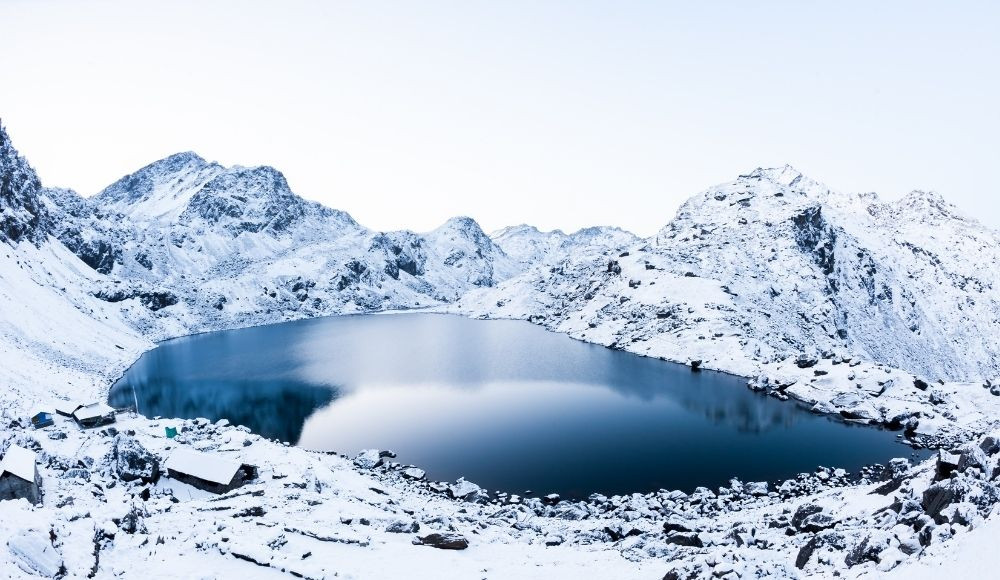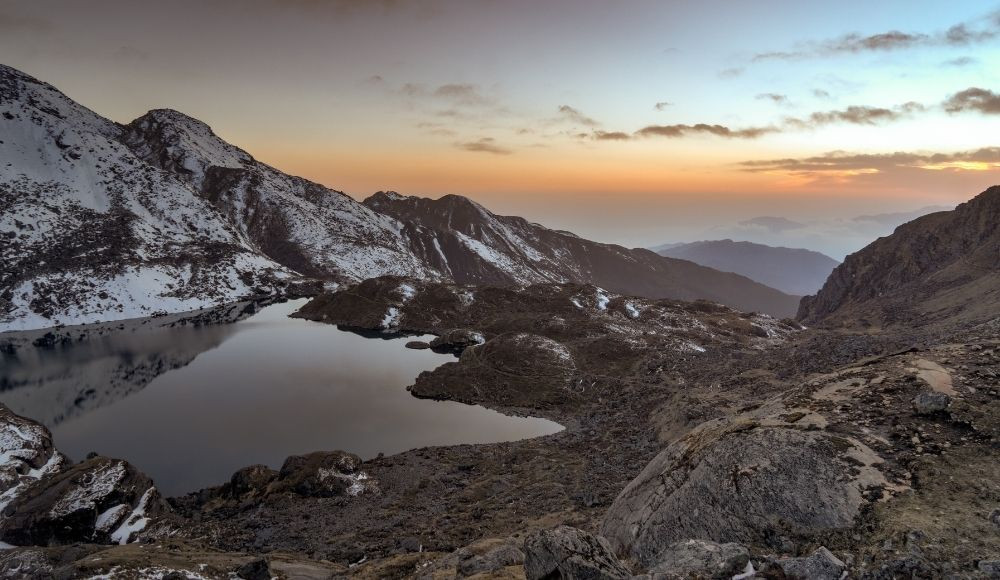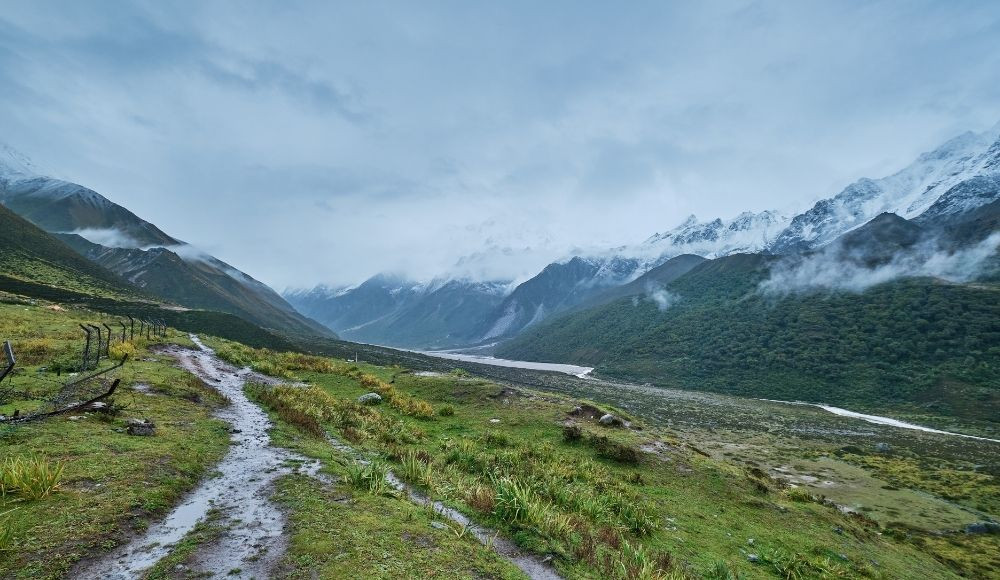Langtang Gosaikunda Lake Trek
Trip Facts
Trip Highlights
- Taste the homely made yak cheese from the cheese factory at Kyanjin Gompa.
- Exploring the Holy and sacred Gosaikunda Lake.
- Sunrise view from Kyanjin Ri.
- Exploring Ancient Gompa and Monasteries of Langtang region.
- Witness the Lifestyle influenced by Tibetan culture.
- Abundant species of Flora and Fauna.
Trip Overview
The best trekking trail near Kathmandu is the Langtang Gosainkunda lake trek. This trek combines the Langtang valley trek and the Gosainkunda lake trek of the same region. Meanwhile, it can also be extended by adding The Helambu circuit from Gosainkunda Lake. With your 13 days Langtang Gosaikunda Trek Itinerary, you will be exploring some of the best destinations of the whole Langtang National Park, one of 12 national parks in Nepal. The trek starts after a long drive from Kathmandu. Similarly, the starting point of the trek is Syabrubesi (Syaphrubesi) and the Ending point of the trek is Dhunche.
Langtang region of Nepal is geographically close to the Tibetan border and remote valleys surrounded by different mountains. Also, It offers you spectacular moments like getting through Langtang National Park and capturing the different species of Flora and Fauna. Langtang Gosaikunda Trek offers wonderful experiences. The Langtang Gosainkunda lake trek is not as hard as it seems. The difficulty level of this trek is moderate and any beginner with a normal fitness level can join this trek. There is no need for Camping throughout the trek as there are enough teahouses and lodges to accommodate the trekkers.
The Langtang Gosainkunda lake trek route is one of the pleasant trekking routes that pass through the rhododendron and Oak forest. Langtang National Park is also home to diversified flora and fauna. Meanwhile, some of the rare species such as Red Panda, snow leopard, clouded leopard, musk deer, and many more. All of their rare flora and fauna are protected by the Langtang National Park Permit and TIMS card and Langtang National Park Permit is required to trek in these regions.
The trek en route through long-steep and descent climate, dense forests, majestic Himalayan views, glaciers, and different lakes. Bordering Tibet, Buddhist culture and religious practices govern the lifestyle of people there. Moreover, Tamang and Sherpa are the major residents. So, You will encounter the Tamang culture and the art of living in the central Himalayas and Helambu region.
What is Langtang Gosainkunda Lake Trek?
The Langtang Gosainkunda lake trek is a 13 days long journey to a new experience. You will be exploring some of the most exciting places in the Langtang Region of Nepal. Gosainkunda lake is one of the popular lakes of Nepal and is also one of the holy lakes of the Hindus. The Sunrise view from the Kyanjin Ri and the sunset view at the Gosainkunda Lake make you forget all of your tiredness and enjoy the beauty of nature. Langtang Gosainkunda Trek starts after a drive from Kathmandu to Syabrubesi which will take about 5-6 hours to reach.
The first day of the trek takes you to the Lama Hotel through the fascinating rhododendron and oak forest. The first day of the trek from Syabrubesi takes about 6 hours to reach. Langtang Village (Valley) is one of the popular villages of the Langtang valley situated at an altitude of 3,430 meters above sea level. You will find the beautiful tradition of Tamang and Sherpa in the village. Explore the unique culture of the locals. The trek to Kyanjin Gompa passes through the main walls and Chorterns in most parts of the trekking trails. Meanwhile, aside from a visit to the local Yak cheese factory, monasteries and gompas can be done during this day.
Kyanjin Ri is the highest point of this trek and about 3-4 hours of the walk is required to reach the top of the hill from Kyanjin Gompa. However, you can extend one day and explore Tserko Ri at an elevation of 5033m/16,512ft. (Hike to Tserko Ri is optional) The next day you will trek towards Lama Hotel vai Ghoda Tabela which translates to (Horse stable) in the native language. You will move towards Thulo Syabru and leave the trail to Syabrubesi. Another day of the walk is required to reach Sing Gompa where you will pass through Dursagang and Foprang Danda. Gosainkunda is the last destination of Langtang Gosainkunda Trek and you will pass through two different lakes before reaching Gosainkunda. The return trail follows the route to Dhunche and Kathmandu. The next alternatives for the return trail can be through Chisapani and Sundarijal.
Gosainkunda Lake (4,460m /14,633ft)
Gosaikunda lies inside the Langtang region at an elevation of 4,460 meters above sea level. It is certainly the most popular religious site in the entire region. Buddhists and Hindus consider this lake a holy and sacred lake. Every year, many visitors visit to take bath in holy Gosaikunda with the belief of getting rid of sins and sorrows. Gosaikunda Langtang Trek also explores untouched modernization and less explored trails, culture, nature, and lifestyle of the Tamang people. Moreover, The trek runs through subtropical regions to the beautiful land.
During the time of Janai Purnima, many devotees visit Gosaikunda Lake. It is believed that after taking a dip in this holy lake all of your sins are washed away. Gosainkunda Lake is not the only lake situated in this Langtang Region. There are other many popular lakes in the Langtang region. Similarly, before reaching Gosainkunda Lake you will pass through two other lakes. According to the legend, Gosainkunda was created by Shiva when he pierced a glacier with his trident to obtain water to quench his thirst after having swallowed a poison that threatened to destroy the world.
Kyanjin Ri (4,773m/15,660ft)
Kyanjin Ri is one of the popular high spots to witness the fascinating views of the mountain ranges and valleys of the Langtang Region. It lies at an elevation of 4,773 meters above sea level and an early morning walk from Kyanjin Gompa is required to reach an amazing sunrise view. There are no sources of water so we recommend you carry as much as you can during the walk to Kyanjin Ri.
The walk to Kyanjin Ri depends on the pace of the traveler. But on average 3-4 hours of the walk is enough to reach the top of the hill. The views are enough to make you forget about your tiredness and difficulties during the uphill walk. Amazing views of the Langtang Lirung, valleys, glaciers and many more can be seen.
Kyanjin Gompa (3870m/12,697ft)
The final destination of the Langtang valley trek is usually Kyanjin Gompa situated at an elevation of 3,870m. Kyanjin Gompa is a prominent Buddhist monastery in the Langtang region. It is a small part of the beautiful Langtang valley that attracts thousands of visitors every year. The absolute presence of nature and gorgeous drop back with divine energy makes Kyanjin Gompa one of the best attractions. The monastery is 700 years old according to the locals and the area has the highest human settlement in Langtang. From this point, one can witness the jaw-dropping view of dozens of mountain peaks including Langtang, Dorje Lakpa, Linrung, Jul, and Gangchemp.
Tserko Ri (5,033m/16,512ft)
Tsergo Ri or Tserko Ri is a mountain peak located southeast of Tsangbu, at an elevation of 5,033 northeast of a small village called Kyanjin Gompa. The Tserko Ri is the ultimate viewpoint towering over almost 1500m above the village. The route to the viewpoint is rigorously steep and quite challenging. From this viewpoint, you get to see a beautiful valley along with an endless chain of snow-capped mountains. The distance from Kyanjin Gompa to Tserko Ri is around 5 km which can be covered in around 5-6 hours. (no teahouses or settlements meaning you will have to carry food and water during the hike and return to the nearest settlement.
If our trip itinerary doesn’t suit your holiday schedule or you wish to modify the itinerary then feel free to inbox us. We want our valuable guests to enjoy their travel according to their needs and wills. We provide a variety of packages for student groups/family groups/corporate teams and many more. Every travel package is different according to the group size and the demand of the guests. We are also more than happy if you combine it with any travel plans, please let us know and we’ll create a tailor-made itinerary, designed especially for your travel group.
Best time to visit Langtang Gosaikunda Lake Trek.
One of the best times to travel the Langtang Gosaikunda lake trek is during March, April, and May. During these months of the year, the trekking trails are filled with the blooming rhododendron throughout the trails. Meanwhile, if you are lucky then you may spot some of the rare and endangered species of animals during the trek such as Red Panda, and Black bear.
October, November, and December are other best times to go on a trek for the Langtang Gosainkunda Trek. During these months of the year, the weather is warm and marvelous views of the mountain ranges can be seen due to the high visibility. The sky is also clear and the morning and nights are cooler. July and August are not so preferable due to the monsoon season. Similarly, there may be low visibility. The valley accepts the ever-changing climate. January and February are not suitable because of the winter season as the snow will make the trek challenging. (During the winter season you may face problems such as snow-covered trails and bad weather conditions). The trekking difficulty level is moderate.
Detailed Itinerary
Kathmandu Arrival. [1,400m/4,593 ft]
Kathmandu to Syabrubesi. [2,380m/7,808 ft]
Syabrubesi to Lama Hotel. [2,560m/8,399 ft]
Lama Hotel to Langtang Village. [3,430m/11,253 ft]
Langtang Village to Kyanjin Gompa, explore Tserko Ri. [4,984m/16,351 ft]
Sunrise from Kyanjin Ri. [4,773m/15,660 ft]
Kyanjin Gompa to Lama Hotel. [2,560m/8,399 ft]
Lama Hotel to Thulo Syabru. [2,150m/7,054 ft]
Thulo Syabru to Sing Gompa. [3,330m/10,925 ft]
Sing Gompa to Gosaikunda Lake. [4,380m/14,370ft]
Gosaikunda to Dhunche. [2,030m/6,660 ft]
Dhunche to Kathmandu. [ 1,400m/ 4,593 ft]
Departure, Farewell.
Trip Guide
The information about the Langtang Gosaikunda Lake Trek is in-depth; feel free to contact us 24/7. We will be available on WhatsApp to assist you instantly. You can write an email if this trip doesn't fit your vacation schedule and requirements. Altitude Himalaya aims to offer the best possible travel experience to customers. Depending on the needs of the visitors and the group size, we customize each vacation package. We will put together a bespoke itinerary just for your private group.
Frequently Asked Questions
-
What is the Langtang Gosaikunda Trek?
The Langtang Gosaikunda Trek is a popular trekking route in Nepal that takes trekkers through the beautiful Langtang Valley, up to the sacred Gosaikunda Lake, and across the Laurebina Pass. This trek offers a mix of stunning mountain views, diverse landscapes, and rich cultural experiences while visiting the Tamang and Sherpa communities along the way.
-
How long does the Langtang Gosaikunda Trek take?
The Langtang Gosaikunda Trek typically takes 12-15 days, depending on the trekker's pace and the specific route taken. Some itineraries may include additional days for acclimatization or exploration.
-
What is the best time to go on the Langtang Gosaikunda Trek?
The best time to go on the Langtang Gosaikunda Trek is during the pre-monsoon season (March to May) and the post-monsoon season (September to November). These seasons offer the best weather conditions, with clear skies, moderate temperatures, and less chance of rain or snow.
-
What is the difficulty level of the Langtang Gosaikunda Trek?
The Langtang Gosaikunda Trek is considered moderate to challenging. The trek involves long days of walking, steep ascents and descents, and high altitudes. Good physical fitness, stamina, and acclimatization are essential for a successful trek.
-
Do I need a guide and porter for the Langtang Gosaikunda Trek?
While it is possible to trek independently, it is recommended to hire a guide and porter for the Langtang Gosaikunda Trek. A guide will help ensure your safety, provide valuable information about the route, culture, and environment, and facilitate interactions with local communities. A porter can help carry your heavy gear, making the trek more enjoyable and less physically demanding.
-
Do I need a permit for the Langtang Gosaikunda Trek?
Yes, trekkers need permits for the Langtang Gosaikunda Trek. You will need the Langtang National Park Entry Permit and the TIMS (Trekkers' Information Management System) card. These permits can be obtained in Kathmandu before starting the trek.
-
What kind of accommodation can I expect during the Langtang Gosaikunda Trek?
Accommodation along the Langtang Gosaikunda Trek is typically in tea houses or lodges. These offer basic facilities, with dormitory-style rooms, shared bathrooms, and meals served in a communal dining area. Some teahouses may offer private rooms with attached bathrooms, but these are limited and can be more expensive.
-
What should I pack for the Langtang Gosaikunda Trek?
Essential items for the Langtang Gosaikunda Trek include a sturdy pair of hiking boots, warm clothing (including layers for temperature changes), a waterproof jacket and pants, a hat and gloves, a comfortable backpack, a water bottle or hydration system, a first-aid kit, and personal toiletries. Additionally, pack a good-quality sleeping bag, trekking poles, and any necessary medications for more information (Nepal trekking gear checklist).
Remember that this list is not exhaustive, and your packing requirements may vary depending on the time of year, your personal preferences, and specific trekking conditions.
-
What are the chances of getting altitude sickness in Langtang Gosaikunda Lake Trek?
During the Langtang Gosaikunda lake trek, you will make your walk to Kyanjin Gompa which is at an elevation of 3870m and you may face some challenges related to high altitude. Also, you will walk to Kyanjin Ri which is at an altitude of 4773m and the chances of getting high altitude sickness might get higher.
-
How to avoid Altitude sickness?
Getting altitude sickness is very unpredictable and it can get anyone although you are physically fit and fine. There are a few things that you can do to avoid getting altitude sickness such as drinking plenty of water (4-6 lt/day), having enough carbohydrates, maintaining a slow and constant walking pace, avoiding alcohol and cigarettes, and last but not least acclimatizing according to the high elevation.
Services Includes
-
All arrivals and departures at Kathmandu airport.
-
A private transfer from Kathmandu to Syabrubesi and Dhunche to Kathmandu.
-
A 3-star hotel accommodation in Kathmandu as per the trek itinerary.
-
Local lodge or tea house accommodation during the trek.
-
Daily breakfast throughout the trip.
-
Lunch and Dinner from trek start day to trek end day.
-
All necessary papers work. (National Park Entry Permits and TIMS Card)
-
An English-speaking, government licensed and experienced trek guide.
-
Porter during the trek. (A porter can carry 20 Kg baggage of 2 people)
-
A well equipped first aid kit.
-
One local SIM card (returnable) during your stay.
-
All government and local taxes.
-
Guide and porter’s salary, food, and accommodation.
-
Arrangement of emergency helicopter service which will be paid for by your traveler’s insurance company.
-
Sleeping bags, duffle bags, and trekking route maps – if necessary.
-
A farewell Nepali dinner on your last night.
Services Excludes
-
Personal expenses.
-
Kathmandu sightseeing and entrance fee.
-
Lunch and dinner in Kathmandu.
-
Nepal visa cost. (You will require 2 passport-size photos and 40 USD for a 30 days Nepal tourist visa; visa forms can be filled out online in advance.)
-
International flight ticket.
-
Travel health insurance. (highly recommended)
-
Tips for the guide, porter, and driver.
-
Sweet things like dessert/chocolate.
-
All alcoholic and non-alcoholic drinks.
-
Hot shower/batteries charge/heater during the trek.
-
Any other expenses which are not mentioned in the including section.
Why Travel With Altitude Himalaya?
We believe in the quality services to accommodate our guests 360 degrees need with tour personalization and customization. Our dedicated and experienced team believes not only in arranging trips, but making creating life long memories. Our travel experience within the region of Nepal, Bhutan and Tibet could make a memorable trip of yours.
Confirm Your reservation Now


TALK TO AN EXPERT
we can help you find your perfect holiday
Mr. Kiran has experience of 10+ years in tourism across Nepal, Bhutan and Tibet holiday arrangements to thousands of travellers from around the world. He will help you to figure out the best possible vacation plan according to your choice and preference.







 Duration
13 days
Duration
13 days
 Trip Difficulty
Difficult
Trip Difficulty
Difficult
 Highest Point
5033m
Highest Point
5033m
 Average Group Size
2-12 Pax
Average Group Size
2-12 Pax
 Trip Code
LGLTAH
Trip Code
LGLTAH
 Area
Langtang Region
Area
Langtang Region
 Start Point
Kathmandu
Start Point
Kathmandu
 Trip End Point
Kathmandu
Trip End Point
Kathmandu
 Accomodation
As Mentioned
Accomodation
As Mentioned
 Meals
As Mentioned
Meals
As Mentioned
 Transportation
On Private Basis
Transportation
On Private Basis
 10 Km
10 Km
 3830m
3830m
 2150 m
2150 m
 Send an email
Send an email +9779823000055
+9779823000055 +9779823000055
+9779823000055